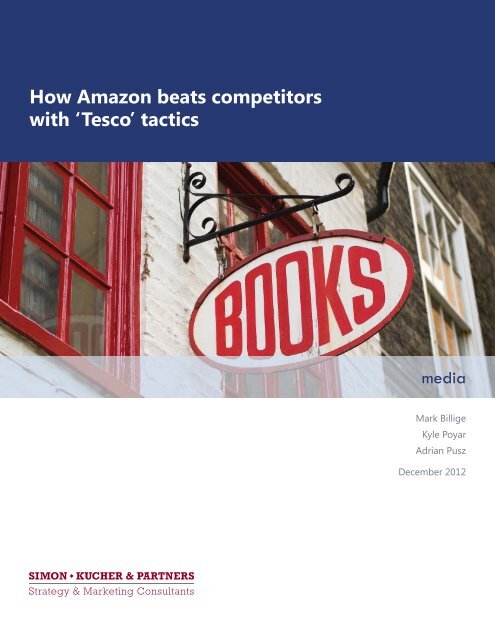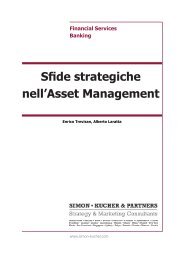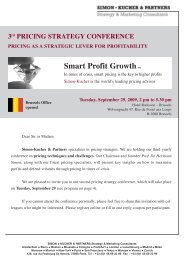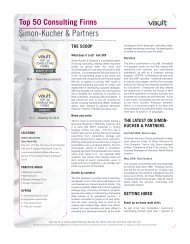How Amazon beats competitors with - Simon-Kucher & Partners
How Amazon beats competitors with - Simon-Kucher & Partners
How Amazon beats competitors with - Simon-Kucher & Partners
- No tags were found...
You also want an ePaper? Increase the reach of your titles
YUMPU automatically turns print PDFs into web optimized ePapers that Google loves.
<strong>How</strong> <strong>Amazon</strong> <strong>beats</strong> <strong>competitors</strong><strong>with</strong> ‘Tesco’ tacticsmediaMark BilligeKyle PoyarAdrian PuszDecember 2012
Setting the right prices – always a book seller’s biggest performancelever – has never been more important because of ever-changing <strong>competitors</strong>,formats, and sales channels. But figuring out the right price for a booknowadays is a jigsaw puzzle <strong>with</strong> half of the pieces missing.Before they start filling in those blanks, however, book sellers should stepback and reconsider some outdated pricing assumptions that may haveserved them well years ago when all books were printed and sold in physicalstores. Book retail labours under several outdated assumptions, primarilyaround how to discount, how to decode <strong>Amazon</strong>’s underlying strategy, andhow to adapt to consumer behaviour in the e-commerce age.To help book sellers improve their price performance and generate smartprofit growth, <strong>Simon</strong>-<strong>Kucher</strong> & <strong>Partners</strong>, a marketing and strategy consultancyspecializing in pricing, undertook an extensive study on the prices ofthe top 100 print books across online book sellers in the U.K. 1Once book sellers have re-thought the assumptions, they need not start theirpricing from scratch. Believe it or not, Tesco has a wonderful model they canborrow and adapt.Outdated assumption 1: Book pricing doesn’t need muchwork (it should largely be “set it and forget it”)Many retailers take a “set it and forget it” approach to pricing, only adjustingprices during pre-defined seasons or promotion events. This is hardly surprisinggiven the number of products they have to manage.<strong>Amazon</strong>, on the other hand, takes a more dynamic approach. <strong>Simon</strong>-<strong>Kucher</strong>looked at how the prices of the monthly top 100 books on <strong>Amazon</strong> changed10 days later. 2 Of the 62 titles that remained in the top 100 over the period,one third had different prices.Missing puzzle piece: Actively managing prices in a smart way helps companieslike <strong>Amazon</strong> boost their profitability. Other book sellers should follow<strong>Amazon</strong>’s lead and develop processes to manage book prices over time.These processes could adjust prices on the basis of book popularity, time ofday, seasons, competitor prices, or other factors altogether. Minor differencesin price applied over time and selectively across the portfolio add up to smartprofit growth.“ Book sellers shouldfollow <strong>Amazon</strong>’s leadand develop processesto manage book pricesover time.”1The study has excluded e-books due to the current legal challenges around e-book pricing2<strong>Simon</strong>-<strong>Kucher</strong> study compared prices of October bestsellers retrieved from <strong>Amazon</strong>’s websiteon October 30 and November bestsellers retrieved on November 9<strong>Simon</strong>-<strong>Kucher</strong> & <strong>Partners</strong> | <strong>How</strong> <strong>Amazon</strong> <strong>beats</strong> <strong>competitors</strong> <strong>with</strong> ‘Tesco’ tactics | December 2012 1
Outdated assumption 2: Consumers buy books onlinemainly to get lower prices<strong>Amazon</strong>’s dynamic pricing strategy reveals a smart insight into consumershopping behaviour. Consumers purchase books online not just because oflower prices, but also for reasons like convenience and a wide selection.A recent <strong>Simon</strong>-<strong>Kucher</strong> survey of U.S. consumers’ multichannel purchasingfound that for 76% of consumers the price of print books was not their mainreason for buying books online. Furthermore, the study found that the morebooks a consumer buys online, the less sensitive to price she becomes.Missing puzzle piece: Book sellers ought to focus on building loyalty andencouraging repeat purchases rather than trying to attract deal hunters <strong>with</strong>deep promotions that destroy profitability. Value-adds such as personalisednewsletters, expert reviews, or user experience improvements are smarterinvestments than aggressively low prices.Outdated assumption 3: Hence, discounts work for booksellers, especially on slow moving productsWhen retailers change prices, it is often to move old inventory. They bring innew, high-demand merchandise at premium prices and quietly discount theirolder and slower moving products.Grocery stores like Tesco do the reverse. They offer low prices on high visibility(“loss leader”) products like nappies, eggs, or milk while maintaining apremium on slower moving or more niche products. So does <strong>Amazon</strong>.From our analysis of <strong>Amazon</strong>’s bestseller list, books in the top 20 sell at higherdiscounts (on average 55% off the list price) than those further down thebestseller list (on average 48% for numbers 21-100).Discounts and product sales often go hand in hand, one might point out. Buta discount difference of 7pp. is unlikely to trigger a volume shift that wouldpush a middling title into the top 10. Rather, this looks like a smart pricingstrategy drawing on lessons outside of the ‘old’ book selling world.Missing puzzle piece: Having lower prices on high visibility products cementsa low price image in the minds of consumers. As in supermarkets,consumers enter the site because they are attracted to discounts on highprofile items (the nappies, eggs, and milk), but may end up buying somethingentirely different. (This is where <strong>Amazon</strong>’s recommendation engine proves soeffective.)“ Grocery stores offer lowprices on high visibilityproducts and maintain apremium on niche ones.So does <strong>Amazon</strong>.”“ For 76% of consumersthe price of print bookswas not their mainreason for buyingbooks online.”<strong>Simon</strong>-<strong>Kucher</strong> & <strong>Partners</strong> | <strong>How</strong> <strong>Amazon</strong> <strong>beats</strong> <strong>competitors</strong> <strong>with</strong> ‘Tesco’ tactics | December 2012 2
Outdated assumption 4: After all, that’s what <strong>Amazon</strong> does(isn’t it?)We already know <strong>Amazon</strong> acts like a grocery store, but we do not know whichone. Is it more like Asda or Tesco (or even Waitrose)?The default assumption would be Asda given <strong>Amazon</strong>’s promise to “offerconsistently low prices on [its] entire catalogue.” 3 That assumption would onlybe partly correct.<strong>Simon</strong>-<strong>Kucher</strong> compared the prices of the top 100 <strong>Amazon</strong> bestsellers againstthe same titles sold online at seven other leading UK bookstores, includingAbe Books, Blackwell’s, Book Depository, and W.H. Smith.<strong>Amazon</strong> has the lowest price on best sellers ...... but not necessarily on less visible booksThe CasualVacancyJ.K. RowlingRank 7MSRP 20.00Price at <strong>Amazon</strong> 9.00Lowest alt. price 9.99Thinking,Fast and SlowDaniel KahnemanRank 53MSRP 8.99Price at <strong>Amazon</strong> 6.02Lowest alt. price 3.46Fifty Shadesof GreyE.L. JamesRank 19MSRP 7.99Price at <strong>Amazon</strong> 2.99Lowest alt. price 3.19Entwined<strong>with</strong> YouSilvia DayRank 76MSRP 7.99Price at <strong>Amazon</strong> 7.19Lowest alt. price 5.99Source: <strong>Simon</strong>-<strong>Kucher</strong> analysis; prices for <strong>Amazon</strong> and competors retrieved on October 30, 2012For titles in the top 20 <strong>Amazon</strong> is on average 6% less expensive than all other<strong>competitors</strong>. On the flip side, <strong>Amazon</strong> charges an average premium of 13%on books in its top 21-50 and 15% on books in its top 51-100 compared tothe competitor <strong>with</strong> the lowest price.<strong>Amazon</strong> still offers its customers competitive prices. But it is strategic aboutwhere it needs to be the absolute lowest price and where a ‘low’ price is sufficient.Missing puzzle piece: While other book sellers are sticking to the high-streetfashion model, <strong>Amazon</strong> is beating them <strong>with</strong> tactics from Tesco.3From <strong>Amazon</strong>’s website<strong>Simon</strong>-<strong>Kucher</strong> & <strong>Partners</strong> | <strong>How</strong> <strong>Amazon</strong> <strong>beats</strong> <strong>competitors</strong> <strong>with</strong> ‘Tesco’ tactics | December 2012 3
Conclusions: Book sellers should act more like Tesco<strong>Amazon</strong>’s strategy is clear, and telling. <strong>Amazon</strong> has leapt ahead of other booksellers by introducing more prices and smarter pricing. They have avoidedcut-throat prices while establishing a low price image <strong>with</strong> consumers.In order to survive, other book sellers must take note and reconsider theiroutdated assumptions. The first place they should look, surprisingly enough,is the neighbourhood Tesco.About the authorsMark Billige is a Managing Partnerof the UK practice at <strong>Simon</strong>-<strong>Kucher</strong>& <strong>Partners</strong> in London.email: mark.billige@simon-kucher.comKyle Poyar is a Consultant at <strong>Simon</strong>-<strong>Kucher</strong> & <strong>Partners</strong> London office. Hisareas of specialisation are publishing,media and telco industries.email: kyle.poyar@simon-kucher.comAdrian Pusz is a Consultant at <strong>Simon</strong>-<strong>Kucher</strong> & <strong>Partners</strong> London office,specialising in consumer behaviour.email: adrian.pusz@simon-kucher.comAbout <strong>Simon</strong>-<strong>Kucher</strong> & <strong>Partners</strong><strong>Simon</strong>-<strong>Kucher</strong> is a global consulting firm specializing in strategy, marketing,pricing and sales. Founded in 1985, the company focuses on Smart ProfitGrowth SM by helping clients to boost their top line instead of cutting costs.With 650 professionals in 25 offices worldwide, our practice is built on evidence-based,practical strategies for profit improvement.www.simon-kucher.comWhat others are sayingPriceless*“ The influence of <strong>Simon</strong>-<strong>Kucher</strong>on the prices we pay for justabout everything is as littlerecognized as it is staggering.”-William Poundstone“...the world’s leadingpricing consultancy...”“...world leader in giving adviceto companies on how to pricetheir products...”*William Poundstone - Priceless: The Myth of Fair Value (and <strong>How</strong> to Take Advantage of It), January, 2010<strong>Simon</strong>-<strong>Kucher</strong> & <strong>Partners</strong> | <strong>How</strong> <strong>Amazon</strong> <strong>beats</strong> <strong>competitors</strong> <strong>with</strong> ‘Tesco’ tactics | December 2012 4
















